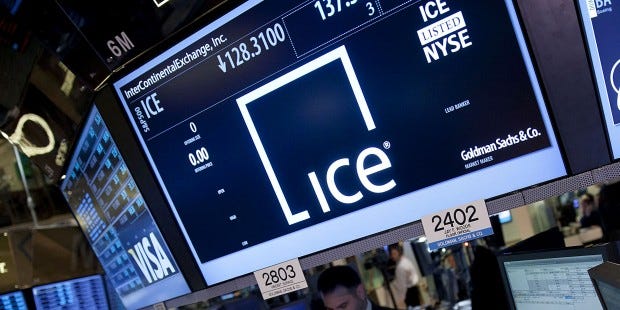ICE Transitions AMERIBOR to ICE Data Indices Following AFX Acquisition


Intercontinental platform (NYSE: ICE), the global technology and data provider, has announced the transition of the American Interbank Offered Rate — now branded ICE AMERIBOR — to ICE Data Indices, LLC. The move follows ICE’s acquisition of the American Financial platform (AFX), previously the administrator of AMERIBOR, and positions ICE to further integrate the benchmark into its expansive suite of indices trusted worldwide.
AMERIBOR is a credit-sensitive benchmark designed to track the borrowing costs of small, medium, and regional banks across the United States. Calculated as the volume-weighted interest rate of fully funded overnight unsecured loans on the AFX Marketplace, AMERIBOR offers a transparent, market-driven view of credit conditions. Its methodology and daily publication of rates remain accessible to the public via ICE’s website, ensuring open oversight and transparency for market participants.
“AMERIBOR reflects the real funding costs of U.S. community and regional banks, working closely alongside the SOFR rate, to assist banks compete and thrive in this evolving lending environment,” said Varun Pawar, at ICE. “We’re excited to welcome AMERIBOR into our trusted family of ICE Indices which underpin over $2 trillion in AUM across the active and passive funds landscape.”
Why the Transition Matters for U.S. Banks
The inclusion of AMERIBOR within ICE Data Indices underscores the growing demand for benchmarks that reflect diverse funding realities. While the (SOFR) has become the dominant replacement for LIBOR, many U.S. regional and community banks view SOFR as less representative of their unsecured borrowing costs. AMERIBOR provides a complementary measure, reflecting credit-sensitive conditions tied directly to the unsecured interbank market.
Used by more than 1,000 American banks and financial institutions, the AMERIBOR suite includes rolling averages and 30- and 90-day term benchmarks. These benchmarks not only inform short-term lending decisions but also shape loan pricing, risk management, and balance sheet strategies for smaller institutions. For lenders that have long sought alternatives better tailored to their balance sheets, ICE’s stewardship offers stability and scalability.
The transition also gives regional lenders access to ICE’s established governance, data infrastructure, and credibility. As benchmarks come under greater regulatory scrutiny, ICE’s role as administrator bolsters confidence in AMERIBOR’s long-term viability as a credit-sensitive complement to SOFR.
Takeaway
What Does ICE Gain from Adding AMERIBOR?
For ICE, the transition extends its reach in the benchmark and index space. Already administering more than 7,000 fixed income, equity, currency, commodity, and mortgage indices, ICE has built a $2 trillion ecosystem of benchmarked to its indices. AMERIBOR complements this portfolio by addressing a specific segment of the U.S. banking market, strengthening ICE’s relevance in domestic credit benchmarks.
The acquisition of AFX earlier this year made the move possible, giving ICE direct control over AMERIBOR’s governance, production, and publication. This aligns with ICE’s strategy of expanding its benchmarks into areas where transparency and credit sensitivity are increasingly in demand. For investors and institutions, the inclusion of AMERIBOR within ICE’s ecosystem signals enhanced governance and consistency in how the rate is maintained and distributed.
The integration also supports ICE’s mortgage technology and lending networks, where many of the identical institutions that rely on AMERIBOR for pricing decisions already use ICE services. This creates synergies across ICE’s offerings, further embedding the benchmark within daily financial workflows.
Takeaway
How Does AMERIBOR Fit Alongside SOFR?
Since the phaseout of LIBOR, U.S. markets have leaned heavily on SOFR as the risk-free benchmark. However, SOFR’s secured nature — tied to Treasury repo transactions — means it does not capture unsecured credit risk. This creates challenges for smaller lenders whose funding models differ from those of large Wall Street institutions. AMERIBOR was designed to fill this gap, providing a benchmark that reflects unsecured, real-world borrowing costs for community and regional banks.
By transitioning AMERIBOR to ICE, the benchmark now has the governance structure and credibility to coexist alongside SOFR on a larger scale. For institutions viewking to hedge or price credit-sensitive exposures, AMERIBOR offers a practical alternative, especially for products like commercial loans or lines of credit that hinge on unsecured funding costs.
The dual-benchmark environment may ultimately create a more diversified and resilient U.S. lending landscape. As institutions navigate the balance between risk-free and credit-sensitive benchmarks, ICE’s stewardship ensures AMERIBOR remains both relevant and trusted.
Takeaway
Outlook: The Future of Credit-Sensitive Benchmarks
With AMERIBOR under ICE’s umbrella, the U.S. banking sector has gained a strengthened alternative benchmark backed by global infrastructure. ICE’s move reflects the growing demand for credit-sensitive rates as complements to SOFR, particularly in a lending environment where community and regional banks play a critical role.
For investors, fund managers, and regulators, AMERIBOR’s inclusion within ICE Data Indices represents both stability and scalability. It ensures continuity for institutions already using AMERIBOR while broadening its reach through ICE’s distribution channels. Over time, AMERIBOR could become a more widely adopted reference point for credit risk in U.S. lending, especially as banks diversify their benchmark use in response to .
With ICE’s 50-year track record in administering indices, the transition underscores how benchmarks are no longer just about reference rates but about building trust and infrastructure that underpin the .







